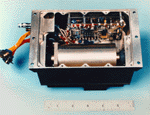 |
All of the data collected by the science instruments will arrive. at Earth by way of radio signals transmitted from the spacecraft. A special group of scientists will use sophisticated computers to analyze these signals. They are interested not in the data contained in the signals, but in the electrical strength and "tone" of the transmissions. The reason for this immense interest is that Surveyor carries a tiny device called the ultra-stable oscillator (USO). This unit acts as an electronic clock that will allow the spacecraft's radio to broadcast signals at an extremely precise frequency.
When in orbit, tiny variations in the strength of the Martian gravity caused by small "blemishes" in the planet's shape will bump the spacecraft slightly from its anticipated path. During these bumps, the "tone" of Surveyor's radio signal will vary by a slight amount. By analyzing these tiny changes, scientists will be able to determine Mars' shape more accurately than ever before. This data will also be combined with the laser altimeter (MOLA) data to improve on the accuracy of the topographical maps.
In addition, this team of "radio scientists" will also conduct occultation experiments. As Surveyor passes over the day side of Mars and approaches the night side, the planet will block radio signals from reaching Earth. Engineers refer to this blockage as an occultation. During the few minutes just before the spacecraft flies behind Mars, and during the few minutes after it reappears, Surveyor's radio signal will pass through the thin Martian atmosphere on its way to Earth. An analysis of the distortion of the signal's strength and tone as it fades and reappears will enable scientists to determine the atmospheric pressure at a specific location on Mars.
During 687 days of mapping operations, the orientation of Earth relative to the spacecraft's orbit will gradually change and allow the radio science team to gather data about the Martian atmosphere all over the planet. When combined with data from the thermal emission spectrometer (TES), scientists will be able to gain a greater understanding of the Martian atmosphere than ever before.